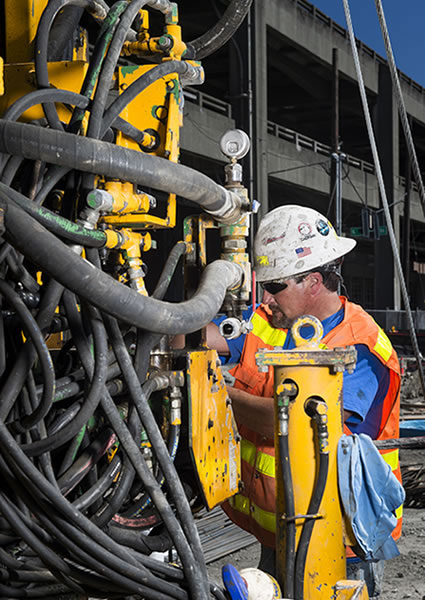
Drilling Glossary
Alluvium
Dediment deposited by flowing water, as in a riverbed, flood plain, or delta. Also called alluvion.
Alluvial gravel
Gravel with sediment.
Aquifer
An underground bed or layer of earth, gravel, or porous stone that yields water.
Auger
A machine having a rotating helical shaft for boring into the earth.
Cable Tool Drilling (Percussion/Drilling and Driving)
Percussion drilling is still used effectively in many parts of the world. Drilling is accomplished using a weighted string of drilling tools attached to hoisting cable that is repeatedly lifted and dropped. The force of the impact crushes the material at the bottom of the borehole. The crushed material is periodically cleared using a bailer. Advantages: low capital investment, low maintenance and operating costs, minimal cross-contamination, water is the only media required for cuttings removal, large diameter holes can be drilled. Disadvantages: drilling is slow in hard formations, boulders are difficult to drive casing through, often requiring the use of dynamite, casing penetration rates decrease with depth in a given formation, noise and vibration can be significant and of special concern when drilling in populated areas or near sensitive structures.
CWD
Persons identified as a “Certified Well Driller” (CWD) and/or “Certified Pump Installer” (CPI or CWD/PI) have earned these designations by passing exams testing their expertise generally and in specific categories. To maintain certification, they must take and report continuing education courses, adhere to high professional standards and have no legal action pending against them pertinent to well construction or water systems installation.
Dual Rotary Drilling (DR Drilling)
The distinguishing feature of the dual rotary rig is a lower rotary drive which is used to independently advance the casing. The rotary top drive handles the inner drill string, which can be tooled with a down-the-hole (DTH) hammer, drag bit, or rolling cone bit. Cuttings are typically removed using air from either the on-board compressor or an auxiliary compressor. Rotary drilling method, employed in conjunction with a cyclone collection system, ensures an accurate sample of the formation being drilled. A key benefit of casing rotation is a straight hole, even when drilling in cobbles and boulders. A straight hole helps to minimize sidewall friction, reduce stress on casing joints and welds and enable greater casing depths.
Gravel
An unconsolidated mixture of rock fragments or pebbles.
Piezometer
A device for measuring pore water pressure (i.e. measuring the location of the water table). Some types of piezometers can also be used for collecting water samples. As a result, wells designed specifically for collecting water samples are often referred to, incorrectly, as piezometers.
Rotary Drilling with Casing Hammer
A casing hammer is a well-established alternative for advancing casing in situations where the hole cannot otherwise be kept open. A rotary top drive rig may be equipped with a casing hammer powered by compressed air, hydraulic or mechanical power that drives the casing as drilling progresses. Typically, a DTH hammer or tri-cone bit is used to open a hole ahead of the casing and is then retracted inside the casing while the casing is driven with the casing driver. The striking action of the casing hammer can be reversed to aid casing removal.
Rotary Drilling (Open-Hole Method with ‘Mud’)
It is possible, in some situations, to keep the hole open while drilling without the benefit of casing. Bentonites and synthetic stabilizers are mixed with water and circulated in the borehole. The resultant fluid, commonly referred to as mud or drilling mud, is used to cake and stabilize the borehole wall. The mass of the fluid also provides pressure in the hole, which helps to keep it open. The drilling fluid is circulated down the hole through the drill pipe, where it exits through ports in the bit. The fluid (mud) flushes the cuttings away from the face of the bit and carries them up the annulus to the surface. Reverse circulation with mud is also possible. In either case, once the mud reaches the surface, it feeds into a settling tank where the cuttings are separated from the mud before it is circulated down the hole again.
Turbid
Having sediment or foreign particles stirred up or suspended; muddy: turbid water.
Turbidity
The amount of sediment or particles suspended in liquid.
Contact us today to talk with a drilling professional about your drilling project.

